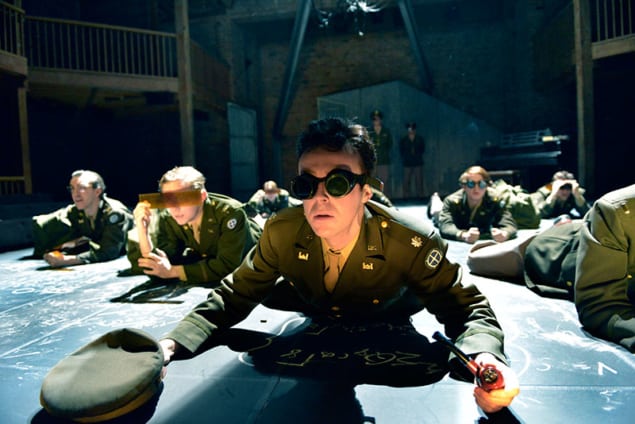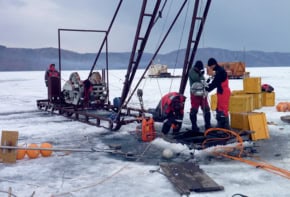Margaret Harris reviews the play Oppenheimer, written by Tom Morton-Smith, directed by Angus Jackson

Was the atomic bombing of Hiroshima and Nagasaki justified? Was it necessary? Were there other – better – options available, either to the scientists who built the bombs or the generals who ordered them dropped? Nearly 70 years later, there are still no settled answers to these questions, and Tom Morton-Smith’s new play Oppenheimer wisely avoids dwelling on the “what ifs” of atomic history. Instead, the play – which runs at the Royal Shakespeare Company’s Swan Theatre in Stratford-upon-Avon until 7 March – focuses on what actually happened, and on the price that the bomb’s scientific father, J Robert Oppenheimer, paid for the fame it brought him.
The journey from idealistic youth to cynical old age is hardly unusual. Even so, it is rare for a human being to travel as far, and as fast, as Oppenheimer did in the late 1930s and early 1940s. As Oppenheimer begins, we see “Oppie” at a party in Berkeley, California with his friends, his students, his younger brother Frank and his sometime lover Jean. The party is a fundraiser for victims of the Spanish Civil War, but as Oppie cheerfully admits, the money they collect is all being “dispersed…distributed…through the Party”. Oppie, it seems, is something of a left-wing Pied Piper, lending socialist books to his physics students even as news of something truly revolutionary – nuclear fission – reaches them from Europe.
By the end of the play, a bomb based on nuclear fission has been built, tested and dropped, and Oppie has betrayed nearly everyone at the party. The idealistic Jean is soon dropped in favour of the cynical Kitty, who becomes Oppie’s wife. Others fall victim to a different kind of lust. When General Groves, military chief of the nascent US bomb project, appears onstage and offers to make Oppie the project’s scientific leader, the deal is conditional: the Berkeley professor must “distance” himself from his lefty associates. Desperately ambitious, Oppie obeys, casting off friends, colleagues and even his own brother like an unstable nucleus sheds particles, until there is almost nothing left.
The analogy between Oppenheimer and an unstable nucleus is Morton-Smith’s own, and he, the Royal Shakespeare Company cast and director Angus Jackson handle the play’s physics content with assurance. It helps that the basic principles of nuclear fission aren’t that difficult. Indeed, fission’s relative simplicity is a problem for the play’s characters: while Oppie worries that the Nazis will get a bomb first, Edward Teller rages that there is “no beauty or elegance” in smashing chunks of uranium together. Beautiful or not, though, the physics in Oppenheimer could easily have been confusing or plodding. The fact that it is neither is a credit to everyone involved.
The play requires a large cast, and several of the supporting actors turn in bravura performances. Thomasin Rand excels as Kitty, a magnificently bitchy drunk, while Catherine Steadman shines as the fragile Jean. Among the men, Ben Allen makes Teller an intriguing mixture of malice and humour, and one of the play’s most moving scenes belongs to Jamie Wilkes, who plays Oppie’s student Bob Serber. Most of the actors are young, which is historically accurate (the average age of the physicists at the wartime Los Alamos laboratory was about 25), and several scenes emphasize the immaturity of the men (and women) who shouldered the titanic responsibility of building the bomb.
The greatest responsibility, of course, fell on Oppenheimer himself, and the same is true for the central character in Morton-Smith’s play. With his lanky frame and pale, expressive face, John Heffernan is perfectly cast as Oppie, and he brings charisma and vulnerability to a role that requires plenty of both. He also revels in his character’s ambiguous morals, hinting that Oppie may regret his own sacrifices as much as he regrets the deaths of Japanese children. That’s a brave suggestion, and it may well be historically accurate. In his monumental 2012 biography Inside the Centre, Ray Monk describes Oppenheimer as “swaggering like a cowboy” after the first atomic bomb test and “raising his hands in the air like a prize-winning boxer” after Hiroshima. Remorse (and high-minded quotations from Hindu scripture) came later.
At just over three hours (including the interval), Oppenheimer is not short, and there is a limit to how many dramatic moments either the play or its audience can withstand. By the time the cast assembles for the first atomic bomb test, we have already witnessed at least four shattering confrontations between Oppie and various other characters. Morton-Smith’s writing – so real and vivid in those personal cataclysms – is also weaker on the symbolism needed to convey the horrors of atomic warfare onstage. A scene where a child actor declaims on the devastation of Hiroshima falls particularly flat, coming across as both unnecessary and overly literal; did they really need to depict a bomb called “Little Boy” as an actual little boy?
These are small things, though, and they do not seriously detract from the play’s considerable emotional punch. Oppenheimer will not change any minds about the bomb’s morality, but it doesn’t have to. “Oppie” and his “boys” did what they did. As a consequence, we live in a nuclear-armed world. What we do about that is up to us.
- Royal Shakespeare Company, Swan Theatre, Stratford-upon-Avon, UK



